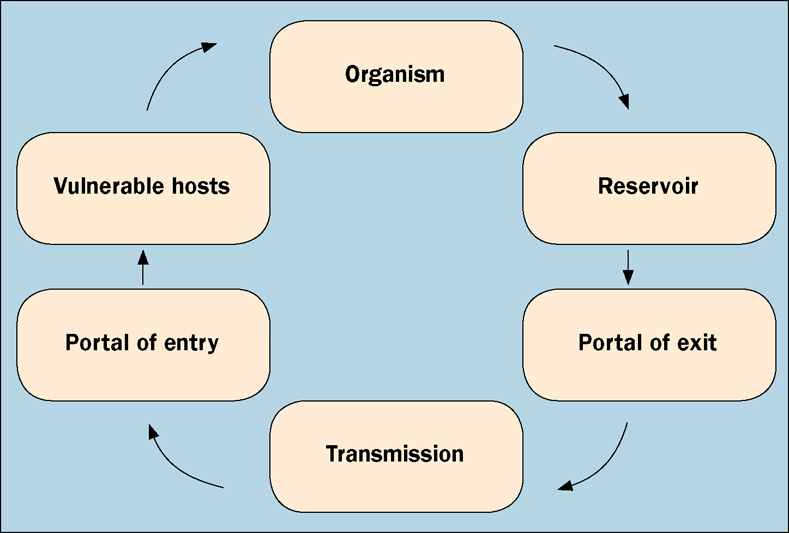What are the stage of Infection, And how the client get infection.
Phase of an Infectious Illness Evaluation.
Any infectious disease develops into five distinct phases. The duration of each phase varies
from one disease to another.
These phases are the following:
A. The Incubation Phase
This is the time between penetration of the pathogen in the body of the receptive host and the onset of clinical signs of disease.
It is that period in which the germ will grow, reproduce, produce toxins and acquire skills that will enable it to cause disease and show clinical signs.
The duration of the incubation period depends on: The amount of absorbed or inoculated germs , The speed of propagation. The distance between the gateway and the preferred site for the proliferation of germs.
B. Invasion Phase
This is the stage of embryo transport after multiplication and reproduction at the site of entrance via blood or lymph to the target organ of infection or spread throughout the body.
The period of invasion is characterized by the appearance of non specific clinical signs, prodromes of fever, malaise, fatigue.
C. The State Period or Full Stage Illness Phase
This is the period of onset of specific clinical manifestations and disease-specific response to physiological and biological target organs caused by the pathogen. It is during this period that the clinical diagnosis of the disease is appear
D. The Convalescent Phase.
This is the phase of restoration of function and morphology of organs. No signs and symptoms of the disease.
Carrier of Infection
This is a person who harbors the agent and disseminates subclinical infections.
Types of Carrier of Diseases
1. Incubating carrier: this is a person in the incubation period of a disease before clinical symptoms appear. Example: HIV, Measles
2. Convalescent carrier: this is a person who continues to harbor the infection after recovery from the disease (after disappearance of the clinical symptoms). Example. 3% of people who recover from typhoid and are not showing the clinical signs of the disease remain carriers for 5 months (after recovery).
3. Temporary carrier: this is a person remaining a carrier for less than 3 months.
4. Chronic carrier: this is a person remaining a carrier for three months or more.
Transmission Route
This is the way the infectious agent is transferred from source (i.e. person, animals, soil ) to the susceptible host.
The main routes of transmission of communicable diseases are:
1. Direct contact (skin, mucous membrane or sexual) Example:. syphilis, gonorrhea, murbug.
2. Vector Example: malaria
3. Faecal contamination of soil, food and water which is ingested. It is also called faecal- oral route e.g. cholera, typhoid…
4. Contact with animals and their products
5. Air (inhalation) Example: tuberculosis, measle, covid-19
6. Transplacental (during pregnancy). Example: toxoplasmosis, syphilis
7. Blood contact (injection, surgery, blood transfusion). Example: HIV
On the basis of routes of transmission, common communicable diseases can be conveniently classified as follows:
a. Water washed diseases Example: scabies
b. Sexually transmitted diseases or infections (STI). Example: gonorrhea, syphilis,mjrbug.
c. Waterborne disease. Example: cholera
d. Airborne diseases. Example: meningitis
e. Vector borne diseases. Example: malaria
f. Water based diseases. Example: bilharzias
g. Zoonotic diseases or Zoonoses: these are diseases that are transmitted to humans by
animals. Example: rabies, trypanosomiasis, anthrax…
h. Faecal-oral diseases. Example: Ascariasis, staphylococcal food poisoning,
Some diseases can be transmitted through more than one route. Example: Syphilis by sex or contact with infective clothes (even if the latter route is rare)
Chain of Spread of Communicable Diseases or Chain of Infection.
The epidemiologic triad illustrates that infectious diseases result from the interaction of the agent, host and environment. More specifically, transmission occurs when the agent leaves its reservoir or host through a portal of exit, and is conveyed by some mode of transmission, and enters through an appropriate portal of entry to infect a susceptible host. This is sometimes called the CHAIN OF INFECTION.
1. Portal of Exist
It is the pathway by which an agent leaves the source host. The portal of exit usually corresponds to the site at which the agent is localized. Thus, the tubercle bacilli and influenza viruses exit through the respiratory tract, schistosomes through urine, vibrio cholerae in feces, and sarcoptic scabbier in skin lesions. Some blood borne agents can exit by crossing the placenta (syphilis...), blood-sucking arthropods (malaria).
2. Portal of Entry
An agent enters a susceptible host through a portal of entry. Often, organisms use the same portal to enter a new host that they use to exit the source host.
Portal of entry may be:
1. The skin and mucous membranes, cuts, natural orifices (skin hair, sebaceous glands,…), Example: Staphylococcus
2. Respiratory tract, Example: Meningococcus, tuberculosis bacilli…
3. Digestive tract, Example: S.typhi, shigella, vibrio cholerae, poliomyelitis virus.
4. Genital tract, Example: STIs, post abortion septicemia, hepatitis B.
5. Accidental ways: during therapeutic maneuvers (injection with non sterile needles, transfusion, venous puncture, lack of asepsis...).
Reservoirs
The reservoir of an agent is the habitat in which an infectious agent normally lives, grows and multiplies and from which it can be transmitted to susceptible hosts.
Reservoirs include humans, animals and environment.
Method or Mode of Transmission
